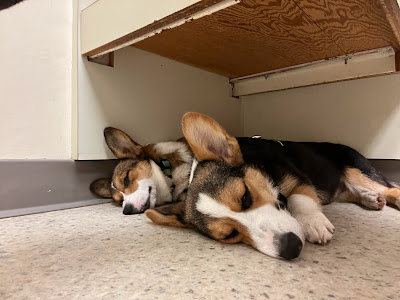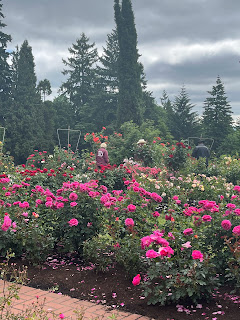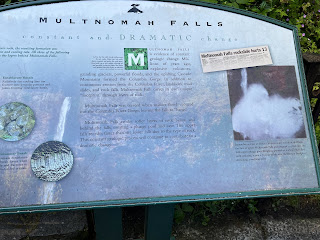
Life is a highway.... I am living a dream as I travel and explore our world. What will I find around the next corner?
Thursday, June 29, 2023
Mt St Helens - 43 years later

Tuesday, June 27, 2023
Value Added
Yup...the pups are now worth far more than when we bought them, if you calculate the "investment" we just laid out on their lives health!!
I grabbed Vickie and took off for the Vet (10 minutes away). Shortly after I arrived the Mister called and said I needed to come back and get Kaitlyn. She was going "downhill - fast!" She was demonstrating tremors and an unstable gait. He found a friend to drive them to the Vet's office and dropped dog #2 with me.
A full blood profile and urinalysis was performed on both puppies. The vet found it interesting that the only number that was outside of the normal range for both dogs was that for TT4 - hyperthyroidism. The vet's first thought was they had ingested some tainted raw meat. Well, there was an interesting morsel on the road of the campground, perhaps a dead bird, when we were walking that at least one dog had investigated... but I didn't recall that either had it in their mouths.
Both dogs were very sick. Obviously they had ingested something that was affecting them. The vet recommended that the dogs have IV fluids and observation for the rest of the day.
Fast Forward.....
We picked up the puppies. What an amazing transformation! Vickie wasn't drooling. Kaitlyn wasn't bobbing her head and staggering when she walked. They were alert and ready to go home.
Reviewing their symptoms, the speed with which they appeared, the different reactions from the dogs and the numbers in their blood profile, as well as the time of year and other patients, the vet concluded that the dogs had ingested metaldehyde, a toxin found in bait for slugs and snails. I had noticed a lot of land snails - of course, the dogs had checked them out. I had not seen evidence of metaldehyde pellets, even though the dogs had been drawn to some areas of shrubs. It is entirely possible that the landscape maintenance guys had broadcast snail pellets under the shrubs to control the destructive animals.
Later I recalled that the dogs had been interested in a mound of dirt from a gopher's tunnel. I figured it just smelled interesting, but then remembered they each picked something up off the mound. I pulled them away, but evidently they ingested it, and that possibly could have been gopher bait.
We will probably never know for certain what it was. The dogs aren't saying a word! All I can say is that they were very sick and happily, have bounced back. Hopefully they will have no lasting effects from the experience.
Sunday, June 25, 2023
Saddlery
Saturday, June 24, 2023
Going Underground - Pendleton
Friday, June 23, 2023
Dam, That's a Lot of Water
We had a quick tour around Portland, then out to the Cascade Locks, the Bonneville Dam and Multnomah Falls.
The highlight of the Portland tour was a stop at the International Rose Test Garden. The flowers were magnificent. The scent enveloped us as we walked around. What fun to see such beautiful blooms without having to lift a finger to make it happen!
Making it Ours - The Master Bath
So, we bought the house....but then we began to say, "what if we did this…. or that?" We couldn't leave well enough alone. We ...

-
I was about 10. I had discovered the secret door to the attic and the mother lode of Christmas gifts hidden within. As I recall, I spent a f...
-
Have you ever thought of the meaning of "four"? Four is the number of: seasons in a year. corners and sides to a square. virtues....





















































